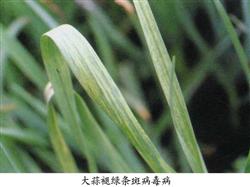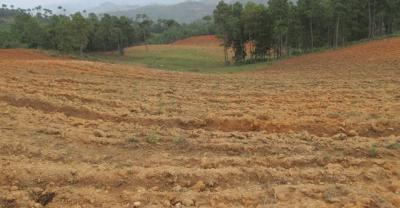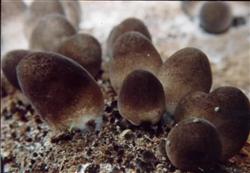atrophy Learn more about atrophy
-
Causes of hypha atrophy in cultivation of Volvariella volvacea

Causes of hypha atrophy in cultivation of Volvariella volvacea
2018-07-01 -
Chicken infectious anemia-pathological changes

The most characteristic pathological change of simple chicken infectious anemia is bone marrow atrophy. The bone marrow of thigh bone is fatty, yellowish or pink; thymus atrophy and hyperemia can lead to complete degeneration. With the increase of age of diseased chickens, thymus atrophy is easier to observe than bone marrow lesions. Fabricius bursa atrophy is not obvious and is often transient. Sometimes the weight decreases and the volume becomes smaller, while the appearance of the bursa of most diseased chickens is translucent. If the condition is serious, the liver and kidney can be enlarged and the yellow substance becomes brittle. Sometimes glandular gastric mucosal bleeding and subcutaneous and muscular bleeding can be seen.
2019-01-16 -
Prevention and treatment of mycelium germination, yellowing and atrophy of edible fungi

Prevention and treatment of mycelium germination, yellowing and atrophy of edible fungi
2018-07-11 -
What happened to the acute atrophy of cucumber in greenhouse

What happened to the acute atrophy of cucumber in greenhouse
2018-07-25 -
Prevention and treatment of emaciation syndrome in sows with emaciated coat and rough muscle atrophy

Prevention and treatment of emaciation syndrome in sows with emaciated coat and rough muscle atrophy
2018-07-11 -
Causes and control methods of mycelium atrophy of the latest edible fungi

Now the cultivation technology of edible mushroom is not difficult, but every step must be strict, there must be omissions, there will be miscellaneous bacteria, diseases and mycelium shrinkage, which is extremely fatal to the cultivation of edible mushroom, seriously affecting the economic income of growers. that
2020-11-10 The latest edible fungi hyphae atrophy causes and control methods -
Causes and control of mycelial atrophy of volvariella volvacea

1. The use of inferior bacteria: the age is too long or too short, the strain degenerates, the mycelium is weak, the stress resistance is poor, or the strain is stored in an environment where the temperature is too low or too high for a long time, there will be the phenomenon of non-germination and mycelium shrinkage after sowing. Prevention and treatment: select the right age, high-quality bacteria, and ensure that the temperature in the culture process is not too low. two。 Improper control of culture material temperature: when the air temperature is high, the culture material is thick, and the heat preservation performance of the mushroom room is good, the temperature in the culture material exceeds 42 ℃ for a long time after sowing, which will lead to mycelium shrinkage, death and burning bacteria.
2019-01-16 -
How does green onion new leaf have white spot dry leaf to bend atrophied to do?

How does green onion new leaf have white spot dry leaf to bend atrophied to do? Please introduce a lot of diseases and insect pests that cause dried yellow leaves of scallion, such as downy mildew, gray mold, blight, virus disease, seed fly, etc. Since the medicine for treating downy mildew, gray mold and blight has no effect, scallion has the greatest possibility of virus disease and damage by seed fly.
2018-09-08 -
Wilt disease (atrophy disease)

Wilt disease (atrophy disease)
2018-05-05 -
Prevention and treatment of mycelium atrophy of mushroom

In mushroom cultivation, it is often encountered that the mycelium does not eat after germination, yellowing and shrinking, which seriously affects the development of mushroom production. The causes and control methods are introduced as follows: first, high-temperature burning bacteria. The temperature in the culture material was higher than 30 ℃ because of the high air temperature during the sowing period, the thickness of the culture material and the unstable decrease of the material temperature after fermentation. Prevention and control methods. The sowing time of mushroom should avoid the high temperature period, and the material temperature should be stable below 25 ℃ when sowing. After sowing, the hyphae are found to have shrunk due to high temperature.
2019-01-16 -
Causes and control methods of mycelium atrophy of mushroom

The cultivation method of mushroom is not difficult, but every step must be strict. Once there are omissions, it is easy to appear miscellaneous bacteria, diseases and even mycelium shrinkage, which is fatal to mushrooms and will affect the harvest of growers. So we
2020-11-08 Mushrooms hyphae atrophy causes and control methods mushrooms -
How to control cucumber vine blight with leaf atrophy and disease spot

How to control cucumber vine blight with leaf atrophy and disease spot
2018-07-14 -
Causes of abnormal growth of volvariella volvacea and preventive measures

Causes of abnormal growth of volvariella volvacea and preventive measures
2019-01-30 -
Reasons and preventive measures for abnormal growth of straw mushroom

Volvariella volvacea is one of the common edible fungi. Its cultivation technology is simple and the planting cost is low, but the income is considerable, so there are many people cultivating it. However, after sowing, there are often some abnormal growth conditions that affect its yield and quality.
2020-11-10 latest straw mushroom growth abnormality cause and preventive measures -
Three common diseases of banana: black spot disease/thin stripe disease/dwarf disease

Banana common diseases small black spot disease, thin stripe disease, atrophy disease and prevention methods introduced, let's take a look at it! Pathogen of microdot disease: The optimum temperature for mycelium growth is 25℃, for spore formation is 13~29℃, and for spore germination is 13~33℃.
2019-05-25 banana common three species disease small black spot thin strip atrophy -
Identification of the advantages and disadvantages of several common mushrooms

Identification of the advantages and disadvantages of several common mushrooms
2018-06-30 -
The advantages of immediate dental implant

Dental implants can only be completed after two operations. the first time is to implant the implants into the alveolar bone and recover them after 3-6 months.
2019-02-22 -
Symptoms of vegetable deficiency in kidney beans

Symptoms of vegetable deficiency in kidney beans
2018-07-01 -
African jasmine pest control, learn four ways to avoid yellowing leaves and plant atrophy

The health of plants is closely related to the environment and methods, and African jasmine is no exception, and the phenomenon of soft and sagging African jasmine leaves encountered by some flower friends can be related to diseases and insect pests. What should we do when we encounter diseases and insect pests? Today, we will explain the prevention and control methods of African jasmine diseases and insect pests.
2018-12-11 -
Control measures for abnormal growth of volvariella volvacea

Volvariella volvacea is a high-temperature edible fungus, which has the largest cultivated area in summer. In the process of volvariella volvacea production, it is common to see pieces of young mushrooms wilting and dying. According to the analysis, there are many reasons for the death of young mushrooms, mainly in the following aspects. (1) the culture material is sour. (2) the material temperature is on the low side or the temperature changes suddenly. Straw mushroom is right.
2018-09-10
